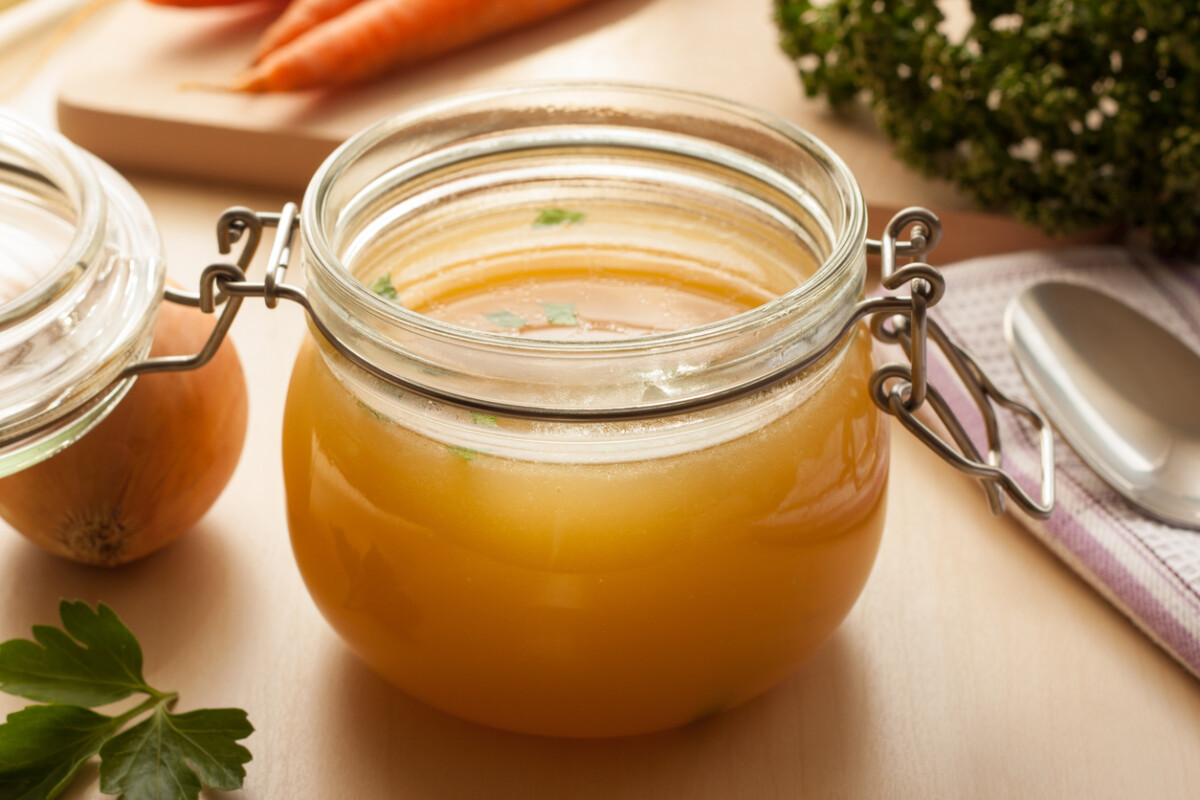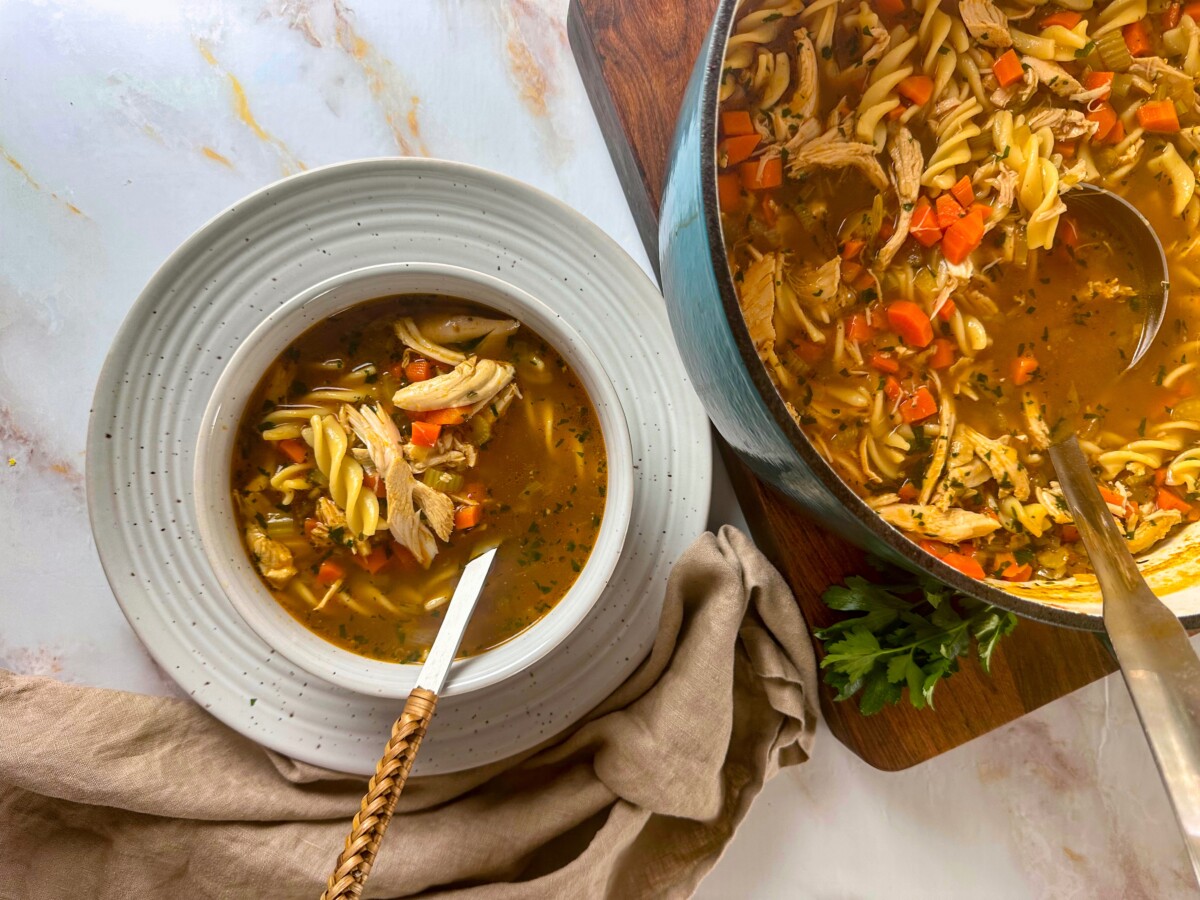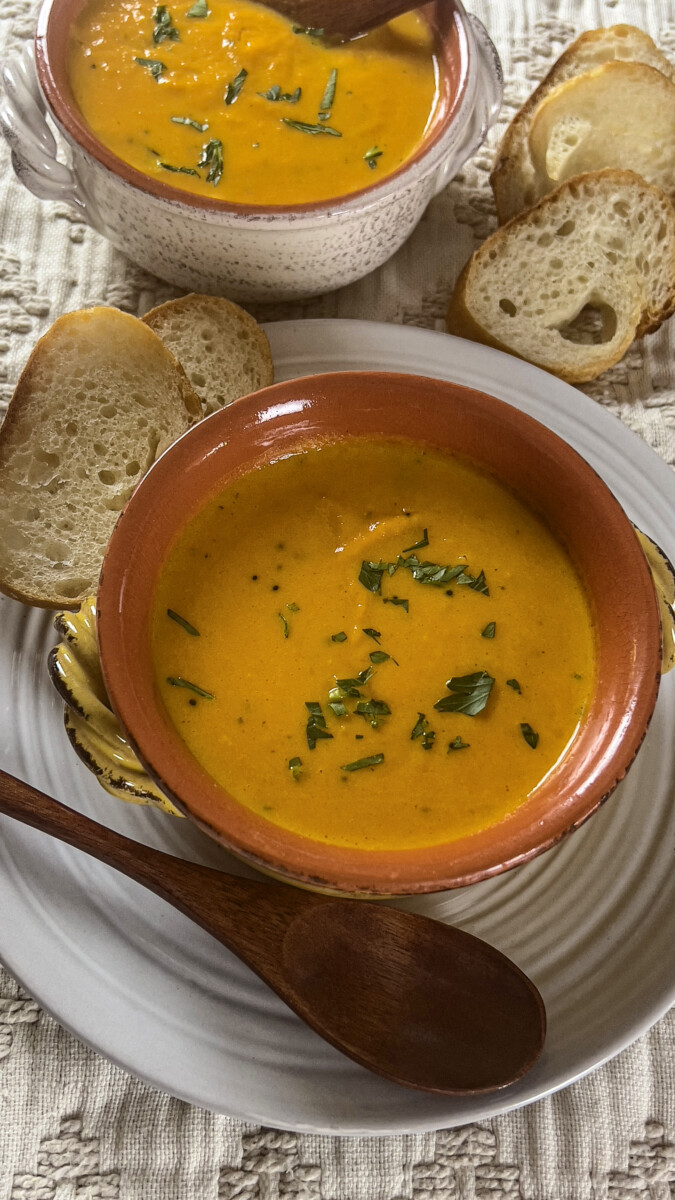
Dipping into the warmth of homemade bone broth. Pure comfort in every ladle!
Join me on a journey exploring broth vs. stock in the heart of the Mediterranean kitchen, where these traditional liquids hold a revered place. Within the culinary tapestry of the Mediterranean, there lies an age-old practice: boiling chicken to extract its flavorsome broth before roasting or baking. This isn’t just limited to chicken. Lamb, a staple in the region, is treated with similar reverence. The derived stock becomes culinary gold, saved meticulously to enhance stews, rice, and grain dishes, adding depth and richness to each bite.
Broth and stock are two pantry essentials every home cook should have in their kitchen, whether they hail from the Mediterranean or anywhere else, and whether it’s store-bought or homemade. Picture this: after a long day, you come home to a delicious, rich aroma wafting through your home. You make your way to the kitchen, and a simmering pot of mouthwatering goodness awaits there. Dinner possibilities seem endless. You can leverage these kitchen staples to economize, reduce food waste, or elevate a dish’s taste profile. Maybe you’re in the mood to sip on them directly, embracing their nutritious warmth. While broth and stock have their similarities, often making them interchangeable, they hold distinct characteristics. The question beckons: what sets them apart, and when does one take precedence over the other?

Lamb broth: A nourishing essence of the Mediterranean. Three jars ready to enrich any dish!
Broth vs. Stock: What’s the Difference?
Simply put, the broth is made by simmering meat and vegetables for a few hours or more, and stock combines animal bones and vegetables instead of meat. Both incorporate aromatics like onions and garlic and are highly customizable.
The broth is quicker and easier to make in a pinch and only simmers for a few hours for a great flavor. It is less full-bodied than stock and tends to contain more sodium due to the meat used. However, if you have leftover meat or seafood and some aromatics, you can whip up a delicious broth in no time. The broth is also easier to make vegetarian than stock because it doesn’t require bones.
Stock requires about four to six hours, but it is worth it. Stock simmers bones, aromatics, herbs, and vegetables together. It is highly customizable, and you can add any vegetables or utilize whatever type of meat, bones, or seafood you have at your disposal. The cartilage and marrow in the bones release proteins and gelatin to enhance the flavors. Animal bones also change the viscosity of the stock, making it thicker and even jelly-like depending on how long you simmer it.
Store-bought or Homemade: Which is Better?
Store-bought broth and stock are acceptable substitutes when you do not have time to make your own. You can also purchase lower sodium options if you are following specific diets for your health. But there is no flavor replacement for delicious homemade broth or stock!
Making homemade broths and stocks is an excellent way to save money on food waste. When you notice produce and herbs starting to wilt, create a broth or stock instead of throwing them away. Garlic, onions, mushrooms, celery, carrots, leeks, parsnips, radishes, and peppers are all wonderful enhancements. It is difficult to go wrong with adding whatever veggies you like. If you have meats left over, simmer them with veggies for a flavorful broth. Seafood, beef, lamb, chicken, and turkey are all delicious choices. For example, don’t throw away the carcass if you bought a rotisserie chicken! Throw the leftover bones in a pot with some water, herbs, and vegetables, and you can utilize every part of your purchase without any food (or money) going to waste.

Nature’s elixir! Fresh chicken bone broth ready to nourish.
Broth vs. Stock: Nutritional Differences
Broth and stock hold an esteemed place in the Mediterranean culinary tradition, embodying both tantalizing flavors and wholesome nutrition. In the past, it was commonplace to simmer meats like chicken and lamb, extracting their essences into nourishing broths before roasting or baking them. This method enriched dishes with multilayered tastes, providing a treasure trove of health advantages. Both these savory liquids brim with nutrients; however, a stock typically boasts a more concentrated collagen profile, credited to its longer simmering time and the infusion of bones. Not only do they enhance a dish’s character, but they’re also robust enough to stand alone as nutritious delights. While they share similarities, there are subtle distinctions between them.
Given the Mediterranean’s vibrant history and culinary artistry, these flavorful brews have more to offer than just taste. They’re reservoirs of health benefits waiting to be explored. Let’s delve deeper into their nutritional compositions and understand their roles in promoting good health.
Protein Content:
- Broth: Being primarily made from simmering meat and vegetables, broths typically contain a moderate amount of protein. The exact amount can vary based on the type and quantity of meat used.
- Stock: Stock generally contains more protein, especially if it’s simmered longer. The bones release collagen, which, when cooked, becomes gelatin—a protein source.
Fat Content:
- Broth: It has a lower fat content since it’s often made from leaner cuts of meat and maybe skimmed fat during cooking.
- Stock: Stock can have a higher fat content due to the marrow in the bones. However, much of this fat can be skimmed off after cooking and cooling.
Minerals & Vitamins:
- Broth: Contains minerals and vitamins from meat and vegetables. These can include potassium, magnesium, and a variety of vitamins depending on the vegetables used.
- Stock: The prolonged simmering of bones in stock can leach more minerals from the bones, potentially offering calcium, phosphorus, and magnesium in addition to those from vegetables.
Sodium:
- Broth: This can be higher in sodium, especially if seasoned during cooking or if using store-bought varieties.
- Stock: Homemade stock is typically lower in sodium unless salt is added. Store-bought versions, however, can be just as high in sodium as broths.
Collagen:
- Broth: It contains minimal collagen since it’s primarily made from meat and not bones.
- Stock: Rich in collagen due to the simmering of bones. This collagen is great for skin, hair, and joint health.
In the Mediterranean diet context, broth and stock can be valuable additions. The diet emphasizes whole foods, lean proteins, and plenty of vegetables—all of which can be found in these nourishing liquids. Whether you’re sipping on a mug of rich bone broth or using vegetable stock as a base for a hearty grain dish, you’re tapping into centuries of Mediterranean culinary wisdom that prioritizes both flavor and health.
How to Make Stock?
Stock takes around 4 hours to make and only has a few simple steps!
- Combine your bones, vegetables, and aromatics in a pot with enough water to cover the ingredients. Bring to a boil.
- Lower the heat to a simmer and occasionally skim the scum and fat layer off the top. The stock will reduce by about a third over 3-4 hours.
- Strain the large debris from your stock with a fine mesh sieve and transfer the liquid into another bowl.
- Use the stock or cool and store it.
How to Make Broth?
The broth is faster to make than stock and is the better option if you only have leftover or uncooked meats and veggies in your fridge.
- Put your meat, veggies, water, and herbs into a pot and boil, then reduce to a simmer.
- Skim the fat and scum off the surface with a ladle or wooden spoon.
- Cook for around an hour or until the meat is cooked. Remove the meat and set it aside for future use.
- Continue to cook the broth for about an hour until slightly reduced.
- Strain the broth and store it.
Storage Insights
Proper storage is essential to maintain the integrity of these culinary delights. Once prepared, let them cool to room temperature before transferring to airtight containers. When refrigerated, they remain fresh for up to four days. If you’re thinking of longer storage durations, freezing is a viable option. Consider dividing them into smaller, portion-sized containers or using ice cube trays to maximize convenience and minimize waste. This way, you can thaw just the right amount for your cooking needs. Furthermore, these frozen portions preserve most flavor and retain their nutritional essence.
Now that we know the differences and health benefits of making homemade broths and stocks, here are some of my favorite recipes. Each recipe is versatile and will be delicious with almost all meals you put on the table.

Chicken broth: a pillar of the Mediterranean kitchen captured in one comforting spoonful.
Wholesome and Healing Chicken Broth
Chicken broth is in countless meal recipes, but did you know it has many beneficial properties when consumed on its own? My homemade chicken broth is filling sustenance that can help if you are not feeling well. Heat it until warm, and sip it like tea. In addition, my chicken broth provides terrific health benefits even if you feel healthy. It is packed with protein and essential fatty acids that help improve digestion, clear your skin, improve sleep, strengthen your immune system, and protect your joints.
Maintain the broth level in the pot after adding the water; as you simmer, the water level will go down. Try adding one cup of water after the first hour of simmering and another at the second hour, and you can maintain a good amount of broth in the final product.

Savoring the depth of lamb broth – meat and bones strained to capture pure goodness.
Healthy and Delicious Lamb Broth
Perfect for hearty soups, stews, or gravies, lamb broth is a favorite among cooks with a preference for more decadent, more flavorful meals. In addition, lamb broth has many health benefits; it contains antioxidants and contributes to hormone production, strength, and cardiovascular health. My mother’s recipe yields a perfectly complete, hearty, healthy lamb broth.

Warm-up and nourish yourself with this Freekeh Soup – a healthy choice for any time of day.
The Best Homemade Freekeh Soup Recipe
When I was younger, my mom always had a soup pot on the stove. The inviting aromas of tender meat and spices would waft through the house, warming the space and making it feel cozy. One of my favorite meals she made was a hearty, nutty soup full of lamb pieces and freekeh called Freekeh Soup. Freekeh is similar to a wheat grain in texture and flavor, derived from green durum wheat. Its smoky, savory flavor is common in many hearty stews, soups, and salads. A good broth like this one will leave you warm and satisfied!

Dig into this bowl of chicken noodle soup – pure comfort and warmth in every bite.
Delicious Traditional Chicken Noodle Soup
Whether you’re feeling a bit under the weather or want to cozy up with a yummy meal on a rainy night, this traditional chicken noodle soup is the answer. This soup is sure to please with a tasty broth, tender chicken, and a colorful mixture of vegetables. Of course, homemade broth makes chicken noodle soup perfectly savory and robust, so use my wholesome chicken broth recipe.








Leave a Reply